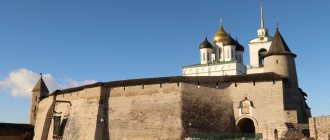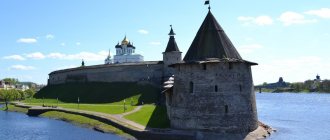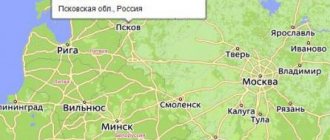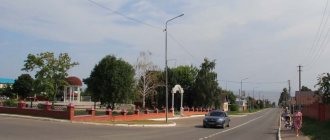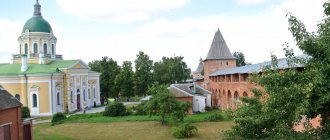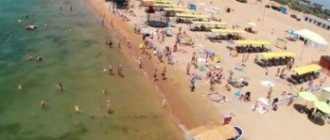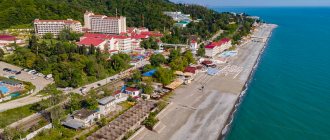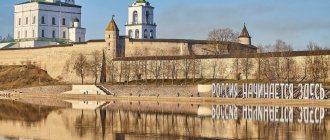| First day Second day Stories, routes and tips from tourists Where to stay in Pskov Excursions from Pskov for 2 days |
Pskov for 2 days is a fascinating journey through ancient Russian lands. Tourists will find here the towers of the ancient Kremlin, centuries-old churches and UNESCO World Heritage Sites. Here you can plunge into the history of the past, when important issues were resolved at the veche, and not far from Pskov the future princess Olga grew up, taking revenge on the Drevlyans for the death of her husband, Prince Igor. For 2 days in Pskov, get ready to see ancient frescoes, fortress walls, chambers of famous families and landscaped embankments.
Pskovsky Krom Photo: © Victor Bashkir
About the city of Pskov
The city of Pskov is located in the north-west of the Russian Federation and is the administrative center of the Pskov region, which borders on three foreign countries: Estonia, Latvia and Belarus, as well as other Russian regions: Leningrad, Novgorod, Tver and Smolensk. The city is almost 800 kilometers away from Moscow. Pskov stands at the confluence of the Velikaya and Pskova rivers. The area of the settlement is just over 95 km2, and the population is more than 210 thousand people.
Pskov is one of the oldest and most beautiful cities in Rus'
Story
Pskov was first mentioned in the Tale of Bygone Years, compiled at the beginning of the 12th century, which talks about the settlement of Pskov (Pleskov), from where in 903 his wife Olga was brought for the Kyiv prince Igor. However, archaeological excavations make it clear that the city appeared much earlier, perhaps even at the turn of the era. But still, the official year of foundation of the city is 903. The appearance of Pskov is associated with a beautiful legend: one day Princess Olga was driving around her possessions and, stopping at the Velikaya River, she saw an amazing phenomenon: three rays descending from the sky connected where the Pskov and Velikaya rivers merge . The princess was amazed by such a miracle, and she decided to found a temple and a city on this place.
From its founding until the 12th century, Pskov was part of Kievan Rus, and after the state collapsed, the city went to Veliky Novgorod. At this time, the first churches and monasteries in Pskov began to be built. A century later, the city gained independence and trade began to develop there. In the middle of the 15th century, the Pskov land flourished, and its own veche was formed here. Due to the fear of attack from the west, the Pskovites built defensive fortresses, of which by 1517 there were more than thirty.
By the middle of the 16th century, the Pskov land practically lost its independence from the Russian state, although it had its own self-government. In 1510 the city finally joined Moscow. 70 years later, Pskov entered the Livonian War, in which it successfully resisted its enemies. In 1611, during the war with Sweden, the Pskovites also managed to defend their territories. At the end of the Northern War, the borders of the Russian state expanded and the Pskov fortress became useless. International trade here began to decline, and Pskov lost its role as an important trade and defensive point, turning into a provincial town.
During the 19th century, Pskov grew significantly, there were more stone buildings
In March 1917, in Pskov, Emperor Nicholas II signed a document abdicating the throne, as a result of which Soviet power was established in Russia. Then the Great Patriotic War happened, in which Pskov played an important role, taking upon itself all the attacks of the enemy trying to approach Leningrad. But still, the Germans managed to destroy the defenses and capture the settlement. The occupation lasted three long years. Only in 1944 was Pskov liberated by Soviet soldiers. In December 2009, Pskov received the title of “City of Military Glory”. Today, Pskov is an industrial city with enterprises producing boat engines, engines, telephone equipment, vehicles and much more.
How to get there
You can get to Pskov by any means of transport, except water:
- Airplane. Pskov airport is called “Crosses” and is located 5 km from the city. You can fly here only from Moscow and St. Petersburg: in the capital, flights are operated by Domodedovo Airport, the journey takes two hours; in St. Petersburg, the flight takes place from Pulkovo Airport, and the travel time is one hour. To get from Kresty airport to Pskov you need to take bus No. 4 or 4A.
- Train. There are four flights daily from Moscow to Pskov. The ticket price starts from 1000 rubles, the journey will take from 12 to 16 hours. Trains depart from Rizhsky, Kursky and Leningradsky stations. The high-speed train “Lastochka” departs from the Northern capital to Pskov daily from the Baltic station. Ticket price: from 650 rubles. Travel time: only 3.5 hours.
- Bus. There are six bus trips from Moscow to Pskov every day. Travel time ranges from 10 to 13 hours, ticket prices start from 1,200 rubles. More than twenty flights depart from St. Petersburg to Pskov every day. The entire journey takes about 4–5 hours, ticket price: from 523 rubles. Buses also go to Pskov from Tallinn, Simferopol, Veliky Novgorod, Smolensk, Riga, etc.
- Automobile. The distance from Moscow to Pskov is 733 kilometers. They can be covered in about 9–10 hours. You should start driving from the capital along the M9 highway, and after the town of Pustoshki turn onto the M20 highway (P23). The road from St. Petersburg goes only along the M20 (P23) highway. The distance between the cities is small - just under 300 kilometers, which can be covered in 2.5–3 hours.
Transport
Pskov is a small city. Public transport here is represented exclusively by buses. Bus routes, of which there are more than 60, connect all areas of the city. The fare is 27 RUB - payment to the conductor. Prices on the page are for March 2021.
Taxi
There are several taxi companies in the city. To call a taxi, short numbers are used, which are usually written on the car. The minimum cost of the trip is 100 RUB. On average, a taxi ride around the city will cost no more than 250 RUB.
In Pskov, it is not customary to hail a taxi on the street. It’s better to order by phone or find a free car in special parking lots, of which there are plenty here.
Sights of Pskov
Thanks to its thousand-year history, the city of Pskov is rich in attractions of various ages and types.
Pskov Kremlin
The historical and architectural center of the city is the Pskov Kremlin, otherwise called Pskov Krom. The fortress was built on a cape, near which the confluence of the Velikaya and Pskov rivers occurs. The area of Krom is three hectares. Its history begins in the 10th century, when local settlers built the first wooden fortress. Then stone fortifications and the first temple were built. In the XIV-XVI centuries, the Kremlin played the role of the official center of the city - local residents gathered here, and important issues were resolved.
The Pskov Kremlin occupies 3 hectares of territory, which is surrounded by fortress stone walls
Address: street Embankment of the Velikaya River. Opening hours: 6.00–22.00. Free admission. Order an excursion - from 150 rubles. per person. How to get there: buses No. 1, 5, 7, 7A, 11, 18, 22, 25, 30, minibuses No. 51 and 51A. Go to the Lenin Square stop.
Trinity Cathedral
Trinity Church is the same temple that was erected on the territory of the Pskov Kremlin in the 10th century by order of Princess Olga. During the history of its existence, the building was rebuilt four times, but still remains one of the most important landmarks of Pskov. The current building was erected in 1699 and is 72 meters high. The traditions of the Moscow style of the 17th century are noticeable in the architecture of the temple. The church operated continuously until 1935, when it was closed by order of the Soviet authorities. At that time, an anti-religious museum functioned here, but in 1941, when the city was occupied by the Germans, the temple again opened its doors to believers. Today the Trinity Cathedral still functions successfully.
Trinity Cathedral - the oldest temple in the name of the Holy Trinity in Rus'
Address: Naberezhnaya Reki Velikaya street, territory of the Pskov Kremlin. Opening hours: 6.00–18.00. Free admission. How to get there: buses No. 1, 5, 7, 7A, 11, 18, 22, 25, 30, minibuses No. 51 and 51A. Go to the Lenin Square stop.
Dovmontov city
Dovmontov town is a unique archaeological site, occupying an area of one and a half hectares. It belongs to the Pskov Krom, but has its own history. The landmark got its name from Prince Dovmont, who ruled Pskov in the second half of the 13th century.
During his reign, Dovmont decided to increase the territory of his possessions, so he began to add new buildings to the walls of the Kremlin. Many houses appeared here, folding into streets, as well as 18 churches. Such a number of religious buildings made this place unique for Russia at that time. However, at the end of the 17th century, Peter I issued a decree on the dismantling of all churches and temples, and in their place he ordered the construction of new fortifications, which were required for the defense of the city in the Northern War. After this event, the Dovmont city was forgotten for three long centuries; only in 1954 were its remains discovered.
Dovmontov city is a unique architectural complex in the center of Pskov, which has no analogues in our country
Address: Naberezhnaya Reki Velikaya street, territory of the Pskov Kremlin. Opening hours: 6.00–22.00. The entrance is free. How to get there: buses No. 1, 5, 7, 7A, 11, 18, 22, 25, 30, minibuses No. 51 and 51A. Go to the Lenin Square stop.
Rattling Tower
The Gremyachaya Tower is part of the Okolny City, which included sixteen towers, but not all have survived. The height of the building reaches twenty meters, which are divided into six tiers. In ancient times, each of them had defensive cannons. The first floor is equipped with an underground passage leading to the coast of the Pskov River.
The popularity of the Gremyachaya Tower is determined by the legends that circulate around it:
- One of them says that once upon a time the Teutonic Knights locked the Pskov prince inside the tower and captured the city. The Pskovites rose to defend their homeland and entered into battle with the enemy, during which the spirit of the prince, who had already died in the tower, frightened the attackers and helped defend the city.
- Another legend tells of a prince's daughter who sleeps soundly inside the tower. She was bewitched by her own mother, and only a man who spends twelve days and nights near the sleeping woman’s bed can remove the spell.
The Gremyachaya Tower is the most mystical place in Pskov, with which many legends are associated.
Currently, the tower is slowly being destroyed, and its complete reconstruction has not yet taken place.
Address: Gremyachaya street, building 8. Opening hours: 24 hours a day. Free admission. How to get there: bus No. 3, minibus No. 51 and 51A. Get off at the Ippodromnaya stop.
Mirozhsky Monastery
The monastery is one of the most ancient in the Pskov region. The date of its foundation is considered to be the 12th century, it was then that the main cathedral of the monastery was erected - the Transfiguration Cathedral, which practically did not undergo reconstruction. The temple has features of classical Byzantine architecture, which is rare for Orthodox churches. Also, the territory of the monastery includes a bell tower, a refectory church, Stephen's Church, the Brotherhood building and a stone house where the abbots of the monastery live. All the buildings of the monastery are decorated with paintings and ancient frescoes, and more than 80 percent of the ancient patterns were preserved on the walls inside the Transfiguration Cathedral. Today the monastery is one of the largest and richest.
Mirozhsky Monastery is famous for its unique, preserved pre-Mongol frescoes
The monastery operated successfully until the beginning of the twentieth century, but then it was closed by the Soviet authorities, and an excursion station was opened in its buildings. Monks appeared here again only in 1994, and in 2011 an icon painting school for children was opened at the monastery. Currently, it also houses a museum dedicated to the history of the monastery.
Address: Mirozhskaya embankment, building 2. Opening hours: 6.00–22.00. Museum opening hours: 11.00–18.00, closed on Mondays. Ticket prices: 200 rubles, students - 150 rubles, schoolchildren - 100 rubles. How to get there: bus No. 2. Go to the Mirozhsky Monastery stop.
Photo gallery: frescoes and temples of the Mirozhsky Monastery
The hands of Byzantine architects belong to the wonderful temple frescoes that covered all surfaces from floor to ceiling, which make a stunning impression on those who see them for the first time
The space of the dome is occupied by the composition “Ascension”
The fresco “Lamentation of Christ” is located in the northern sector of the vault and is especially popular
Despite the antiquity of the frescoes, they were discovered about a century and a half ago; until that time, unique decorations were hidden under a thick layer of whitewash and paints
The drawings depict the warriors Sergius and Bacchus, the holy healers Panteleimon, John and Cyrus, the martyrs Romulus and Eudokius, and here you can also see images of the saints Apexim, Aifal, Joseph and the Monk Euphrosynus and Nikon
The fresco “The Savior on the Throne” is located on the central apse
The Transfiguration Cathedral functions as a museum, and services are not held here; the building and courtyard of the church are filled with parishioners only once a year - on the Transfiguration of the Lord
Stephen's Church was built in 1604; its main attraction is the unique iconostasis, filled with frescoes.
The authorship of the drawings belongs to Archimandrite Zinon, he also painted the iconostases of the Trinity-Sergius Lavra, the Danilov Monastery, and he also painted many other Russian and foreign churches
Old Ascension Convent
The exact date of foundation of the monastery is unknown, but one thing is clear - it was built before the 15th century. The main building is the Ascension Cathedral, erected on the site of an old wooden church in the 30s of the 16th century. During its history, the monastery changed its direction several times, becoming either male or female, and was often in dire straits. The 19th century marked the heyday of the monastery: the Church of the Nativity of the Virgin Mary, in the Empire style, was built here, then the Church of the Blessed Virgin Mary of Tikhvin, as well as a fence, cells and a chapel. In the post-revolutionary period, the monastery was closed, and the buildings were occupied by the NKVD, OGPU and police services. Today, only one Church of the Ascension is functioning for its intended purpose, while other buildings house the Pskov planetarium and observatory.
The Church of the Ascension of the Lord, better known as the Old Ascension, is one of the most significant and revered churches in Pskov
Address: Sovetskaya street, houses 62A, 62B, 62B, 64A. How to get there: bus No. 2, 11, minibus No. 2T, 51, 51A. Get off at the stop "Victory Square" or "Children's Park".
Snetogorsk Monastery
The first mention of the Snetogorsk monastery in chronicles dates back to the end of the 13th century, when it was burned by Livonian knights. This means that the foundation of the laurel occurred even earlier. In subsequent years, the monastery was rebuilt again: in the 14th century the Cathedral of the Nativity of the Virgin Mary appeared, in the 16th century - the Church of St. Nicholas the Wonderworker, the Ascension Church and the bell tower. Since the 15th century, the monastery occupied the place of the cultural and spiritual center of the Pskov region, but then was partially destroyed during the Livonian and Northern Wars. During the Second World War, the Wehrmacht headquarters was located on the territory of the monastery.
Snetogorsky Monastery stands on the elevated bank of the Velikaya River
Today the monastery is still in operation. The main thing worth seeing is the Cathedral of the Nativity of the Virgin Mary. Its interior has an unusual style - there are frescoes on a biblical theme, interpreted in a free style. The saints are depicted as ordinary people who do not carry any religious symbolism. Today, the images are practically invisible, and work on their restoration has been going on for about a hundred years.
The Cathedral of the Nativity of the Virgin Mary of the Snetogorsk Monastery is a world cultural monument
Address: Snyatnaya Gora street, building 1. Opening hours: 8.00–21.00. Free admission. How to get there: bus No. 1. Get off at the final stop “Snatna Gora”.
Photo gallery: frescoes of the Cathedral of the Nativity of the Virgin Mary
The first frescoes appeared on the walls of the temple in 1313
Unlike other monasteries and temples of that time, which were painted by Greek masters, the main temple of the Snetogorsk monastery was painted by Pskov masters
During the war with the Polish prince Stefan Batory, the frescoes were damaged and completely whitewashed, which may have saved them from complete disappearance
The frescoes were discovered in 1910, and their restoration began at the same time.
Today, restoration work is still ongoing, but you can already admire these ancient paintings
The western part of the temple is decorated with frescoes depicting the Last Judgment
Olginskaya Chapel
According to legend, the chapel was installed exactly on the spot where Princess Olga stood when she saw the heavenly rays, thanks to which the city of Pskov appeared. At first a memorial cross was simply erected here, and later a chapel was built. However, the old building was demolished in 1960, and a new one was erected only at the beginning of the 21st century.
Grand Duchess Olga, Equal to the Apostles, the first Christian in Rus', was especially revered in her homeland, in Pskov
Address: Olginskaya embankment, building 4A. How to get there: bus No. 3, 4, 5, 7, 14. Get off at the “Maxim Gorky Street” stop.
St. John the Baptist Cathedral
Presumably the cathedral was built in the 12th century and belonged to the Ivanovo convent, which was destroyed under Soviet rule. However, the cathedral itself avoided such a fate. In 1990, it was restored and again handed over to believers. The appearance of the temple is not similar to all other religious buildings in Pskov: there are no external decorations, but the interiors of the building are richly decorated. Previously, the walls were decorated with frescoes and paintings, some of which are kept in the Tretyakov Gallery, but today's pattern is the result of the work of modern masters.
The cathedral develops the features of Novgorod religious buildings of the 11th - 12th centuries and has no analogues in Pskov architecture
Address: Maxim Gorky Street, building 1. How to get there: bus No. 2, 3, 4, 7, 14, 15, 17, 22, 25, 30. Get off at the Petrovskaya Street stop.
Church of Constantine and Helena
The temple was built in the 17th century and has an architecture typical of Pskov buildings of that time. This is a unique church, the appearance of which has practically never changed throughout its history. However, the interior decoration could not be preserved, because under Soviet rule the building housed a speleologists’ club and artist’s workshops. During the era of the decline of Soviet power, the church became operational again, and its interior was restored by the parishioners. What makes the church unique is the fact that exorcism sessions take place within its walls.
The Church of Saints Constantine and Helena was recently abandoned and destroyed, presenting a sad sight, now the temple has been transformed, it has been restored, the chapel of Blessed Xenia has appeared
Address: Krasnogorskaya street, building 26. How to get there: bus No. 3 or 5. Get off at the “Ippodromnaya” stop.
Museum of Local Lore
The museum began its work in 1876. Its exposition is so huge that it will take several days to study it. According to some estimates, the museum houses more than 500,000 exhibits.
The museum is a complex of buildings, which includes:
- Transfiguration Cathedral;
- Mirozhsky Monastery;
- Order chambers;
- Pogankin chambers.
Pogankin chambers
The chambers were built at the end of the 17th century by order of the merchant Pogankin. Their walls were supposed to house a residential building, a warehouse and a factory. The style of construction was typical of all fortress houses of that time: high walls and small windows. Today, the building is given over to the local history museum, is its main building and houses an exhibition under its roof, where archaeological finds, old handwritten monuments, ancient icons and silver items are presented.
The Pogankin Chambers were erected in 1670
Address: Nekrasova street, building 7. Opening hours: 11.00–18.00, closed on Monday, the last Tuesday of each month. Entrance ticket prices: 200 rubles, students - 100 rubles, schoolchildren - 60 rubles. How to get there: bus No. 1, 2, 2A, 4, 5,6, 16, 19, minibus No. 2T, 4A. Get off at the stop "Victory Square" or "Children's Park".
Order chambers
The chambers are an administrative building dating back to the 17th century. Previously, officials, ambassadors, bankers and city administration met here. Initially, the building was made of wood, but due to constant fires, the walls of the building were built of stone, and their thickness reached two meters. Today, the building houses a branch of the Local History Museum, which stores historical artifacts, and the interiors of those times have been recreated in the offices where the clerk and governor used to sit.
Prikaznye chambers - a medieval stone building built in 1693
Address: territory of the Pskov Kremlin, building 4. Opening hours: 11.00–18.00, weekends - Monday and Tuesday. Entrance ticket prices: 80 rubles, students - 50 rubles, schoolchildren and pensioners - 40 rubles. How to get there: buses No. 1, 5, 7, 7A, 11, 18, 22, 25, 30, minibuses No. 51 and 51A. Go to the Lenin Square stop.
Photo gallery: Museum in the Executive Chambers
The currently existing roof corresponds to the appearance of the 17th century, and the ancient hipped roof is planned to be restored during the next restoration of the chambers
Here the collection of taxes and duties took place, the expense books of the Order Chamber were kept and units of measurement were stored
The clerk supervised all the clerks, his desk stood in the governor’s office
The interpreters who worked at the embassy table had to know several foreign languages
Museum "Two Captains"
The museum was opened at the children's and youth library in 2002. The writer Veniamin Aleksandrovich Kaverin, the author of the novel “Two Captains,” is a native of the city of Pskov. The museum exposition tells not only about the novel “Two Captains” and the history of its writing, but also about the biography of the writer, as well as the life of his family. In addition, the exhibition tells the story of those people who became the prototypes of the heroes of the famous work.
In the eighties, Veniamin Kaverin actively collaborated with the library; he donated many of his manuscripts and books to the institution, and the writer himself chose a sketch to create a monument
Next to the library building there is a thematic sculpture that appeared here in 2005.
Address: Oktyabrsky Avenue, building 7A. The museum is closed for reconstruction. How to get there: bus No. 1, 8, 11, 14, 17, get off at the “House of Soviets” stop.
Mason's House
The building was erected at the beginning of the twentieth century. The architectural style of the building is modern. Despite its name, the house has nothing to do with secret societies. Everything is much simpler: at the end of the 19th century, the Scotsman Ludwig Mason lived here. Local residents mispronounced his last name, which is where the nickname “Mason” came from. He lived here before the revolution, and then disappeared without a trace. The building was given over to communal apartments. In 2002, the building was transferred to the Pskov Historical, Architectural and Art Museum-Reserve, which uses it as a storage facility for valuable things:
- silver and gold coins;
- antique jewelry;
- collectible weapons;
- treasures found during archaeological excavations.
According to research, the Mason's house stands on the site of the cathedral church of the Chrysostom Medvedev Monastery, which served as the tomb of the Pogankin family of merchants.
The repository is open to the public, so anyone can see the valuable fund. In addition, the building houses the Heraldic Hall, which displays the coats of arms of various Pskov counties, household items of local residents of the 19th-20th centuries, paintings on canvas, weapons of the Russian army, medals and orders.
Address: Komsomolsky lane, building 6. To visit the storage facility, you must make an appointment with the guide by phone in advance. Ticket prices: from 150 rub. How to get there: bus No. 1, 3, 4, 5, 11, 14, 14A, 15, 17, 19 minibus No. 4A, 14T, 51. Get off at the “Summer Garden” stop.
Interesting streets and squares of the city
The most interesting locations for tourists will be the following Pskov locations:
- "Golden Embankment". This is what local residents call the Primostye quarter, located on Sovetskaya Embankment. All the buildings here were erected not so long ago, but fully comply with the traditions of the ancient houses of the city. How to get there: bus No. 1, 7, 7A, 25, minibus No. 51, 51A. Get off at the stop “Ulitsa Alexandra Nevskogo”.
The Golden Embankment is located in the historical center of Pskov, just a stone's throw from the Kremlin, just cross a small bridge - October prospect. The avenue is one of the central streets of the city. Almost every building here is an architectural monument. Most of the buildings were built in the late 19th and early 20th centuries. How to get there: bus No. 1, 2, 2A, 5 14, 14A, minibus No. 2T, 14T, 51, 51A. Get off at the stop “Ulitsa Metallistov”, “Torgovy”.
- Square of victory. The square is dedicated to the occupation of Pskov during the Great Patriotic War. There is a monument to the Unknown Soldier and the Eternal Flame burns here. Nearby there are bas-reliefs that tell the military history of the city: all the wars in which Pskov itself or its natives participated are shown. How to get there: bus No. 2, 2A, 5, 6, 11, 16, 19, minibus No. 2T. Get off at the “Ploshchad Pobedy” stop.
Monuments
Popular monuments of Pskov are:
- Monument to Princess Olga. The princess is a cult personality for Pskov. Local residents love and respect their ancient countrywoman very much and dedicate various buildings to her. So, in 2008, a monument to the princess appeared here, the installation of which coincided with the 1100th birthday of the city. Address: Children's Park. How to get there: bus No. 3, 4, 5, 11, 14. Get off at the “Children's Park” stop.
Princess Olga is the most revered saint in Pskov, because it was on her order that the Holy Trinity Monastery was built, which gave rise to the glorious history of the Pskov land - Monument to Pushkin and Arina Rodionovna. The monument was erected in 1983 and is called “Pushkin and the Peasant Woman”. The uniqueness of the sculpture is that it is the only one of its kind, depicting the great poet together with his beloved nanny. Pushkin's fate is inextricably linked with Pskov: he often came here and was inspired by the local nature. It was in Pskov that the chapters of “Eugene Onegin” and “Boris Godunov” were written, and also some of the writer’s fairy tales were born. Address: Summer Garden. How to get there: bus No. 1, 3, 8, 11, 14, 14A, minibus No. 14T, 51A, 51. Get off at the “Summer Garden” stop.
The monument has the official name “Pushkin and the Peasant Woman”, but it is better known as “Pushkin and the Nanny”
What to see if you come with a child
Tourists with children will not be bored in Pskov. The child will definitely love the Pskov Kremlin, because all kids are interested in climbing the fortress, exploring the ancient towers and fortifications. Temples and monasteries will be a fascinating place for older children, especially those who are interested in ancient architecture. For very young children, the Children's Park has a variety of attractions, and you can also ride a velomobile there.
A traveler with a child can go to the picturesque surroundings of Pskov, where it will be interesting not only for the child, but also for his parents. The Pushkin Mountains are a place where there is freedom for games and exciting discoveries. In addition, in the suburbs you can unexpectedly meet storks that often walk here. Not far from Pskov there is an eco-park “Zoograd”, in which pets live outside of cages, so the child can freely contact the animals.
The Pushkin Mountains are located one hundred kilometers from Pskov
Ecopark address: Pushkinskie Gory town, Zapadnaya street, building 34. Opening hours: in summer - 10.00–20.00, in winter - 11.00–18.00. Cost of visiting: 200 rubles, children under 14 years old - 100 rubles.
The Pskov House of Crafts will delight your child with master classes, during which the child will be able to make a toy from clay with his own hands. Most of the city's museums include excursions aimed at children of all ages.
Address of the House of Crafts: Nekrasova Street, building 8. Opening hours: 9.00–18.00. Cost of a master class for a child: from 200 rubles.
Sculpture "Mother and Child"
Not far away, in the depths of the Botanical Garden, the “Mother and Child” monument hid from prying eyes. It is believed that the monument was erected in the 70s of the 20th century, but neither its exact name nor the author are known.
The sculpture represents motherhood, love and care. The composition represents a woman with a child frolicking on her lap. The sculpture is made of granite and has vague outlines, which gives it imagery and symbolism. The image is very gentle and touches the most delicate strings of the soul, evokes warm and bright feelings.
How long does it take to look around the city?
There are many attractions in Pskov that are unlikely to be explored in one day. Although most of them are located in the central part of the settlement, it is still better to devote at least two days to the city:
- The first day should start with a visit to the Museum of Local Lore. Then you should go to the Pskov Kremlin - explore the fortress itself, Dovmont city and the Trinity Cathedral. After the Kremlin, you can visit several religious buildings, and finally take a walk along one of the picturesque streets of the city.
It will take several hours to explore the Pskov Kremlin - The second day begins with a visit to the monasteries and temples of the city. After thoroughly enjoying the religious architecture, you can visit the “Two Captains” museum and then go to the Mason’s house. At the end of the trip, you should visit the monument to the founder of the city - Princess Olga.
Square "Gnomes"
Next to the Kremlin ensemble, in a small park between Sovetskaya Street, Lenin Square and Olginsky Bridge, there is a composition pleasing to the eye: a tall flowerbed with a spruce tree in the middle and seven dwarves.
Each fairy-tale character “lives” in his own “house” - a hemisphere in a concrete niche. Snow White is not with them, and the dwarves sometimes disappear somewhere. However, children like to climb into empty niches and imagine themselves as fairy-tale characters.
The author of the composition is the chief artist of the Pskov ceramics plant, Alexey Agarkov. At first, all the gnomes were gray, but in the 2000s they were painted with bright colors.
Tips for staying in the city
Pskov is a rather large city, and all the main attractions are located in the central part. Therefore, when choosing a hotel, it is better to choose options located in the center. You can come to the city at any time of the year. All museums and attractions are open to the public in winter, summer, and off-season. However, the most popular time of year for tourists to visit Pskov is, of course, summer. It is during the warm season that most travelers gather here, but this will not affect comfort in any way: there are still no long queues to attractions and museums. The air temperature in the city barely exceeds 20 degrees, but heavy downpours are common, so it is better to take an umbrella or raincoat with you on your trip.
Summer Pskov rain can flood roadways and pedestrian areas of the city
What to bring as a souvenir
In addition to standard souvenirs, you can bring from Pskov:
- Ceramic products. Pskov ceramics are known not only throughout Russia, but also abroad. The souvenir will be a pleasant and useful gift, because ceramic dishes can be used in everyday life.
, produces homemade, cute dishes that create incredible comfort in the kitchen - Forged souvenirs. Forging is another calling card of Pskov. Local craftsmen won the trust of Peter I himself, who at one time noted the increased functionality of local forged products. As a souvenir you can buy a small belfry, a coin or a forged magnet.
- Gifts made from linen. Linen towels, tablecloths, shirts and much more can be purchased in Pskov as gifts for loved ones. Some craftsmen hand weave thin lace from flax and decorate it with patterns and intricate embroidery.
- Religious souvenirs. In the city, which is home to more than thirty temples, religious souvenirs are especially popular. In church shops at churches and monasteries you can buy icons, crosses, prayer books and much more.
Monument to Skobar
In the center of Pskov there is an interesting architectural form dedicated to the Pskov blacksmiths, who were famous throughout Russia. The bronze “Skobar” appeared in the Children’s Park in 2014 as part of the celebration of the 1111th anniversary of the city’s first mention in the chronicle, the author of the sculpture is Igor Golubev.
Skobar sits on a bench and hands out a horseshoe to those around him, as if giving happiness to everyone passing by. Pskov residents and guests of the city often enlist his support: they rub a horseshoe, a nose, a shoe, sit on the blacksmith’s lap and make wishes, and take pictures against the backdrop of an unusual sculpture. They say that Skobar fulfills his deepest dreams.
